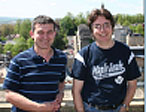The chemistry of main group elements is an exciting and diverse subject. Fundamental
exploratory studies in this area have led to
numerous advances that have profoundly
affected our understanding of chemical
science and, in many cases, have led to
important commercial applications. Basic
research in phosphorus, boron, and silicon
chemistry, for example, has enabled the
development of new types of compound and
important new reactions that are widely utilized today: phosphines as ligands in catalysis, hydroboration for functional group transformations in pharmaceutical synthesis, and silicone polymers as materials with unique properties.
With the future importance of this key
area of chemistry in mind, we are delighted
to have established a Centre for Main Group
Chemistry at the University of Bristol.
We wished to choose a name for the
centre that reflected the multi-disciplinary nature of the subject and the diversity of
the research performed in different cutting
edge areas at the University of Bristol.
To launch the Centre, we held a
one day symposium in July 2006 with contributions from leading international experts in main group chemistry.
We thank both our sponsors and the
speakers who kindly agreed to take
part in this symposium.
 With best wishes
With best wishes
Chris Russell (Director)
Ian Manners